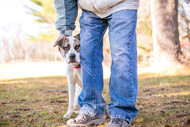Understanding Dog Body Language Beyond Chew Time: Strengthen Your Bond by Learning How Dogs Truly Communicate
Posted by Greg C. on Jun 02, 2025
Dogs are constantly communicating. Every tilt of the head, twitch of the ear, or change in posture is part of a language they use to navigate their world—and build trust with you. While chew time is often a moment of comfort and contentment, understanding what your pup is expressing the rest of the time helps deepen that bond even more.
Let’s decode what your dog’s really saying, and how you can respond in a way that builds confidence, security, and connection—on walks, during training, or just lounging at home with a good, all-natural chew.
How Dogs "Speak" Without Words
Dogs may not talk, but they’re definitely not silent. Through a combination of body posture, tail position, facial expressions, and even scent and sound cues, dogs share how they’re feeling moment to moment.
- Tail Language: A relaxed, mid-height tail wagging loosely usually means your pup is calm and content. A stiff, high tail can signal alertness or assertiveness, while a tucked tail may indicate fear or submission.
- Ears and Eyes: Forward-facing ears might mean interest, while ears pinned back could suggest fear or uncertainty. Dilated pupils can reflect stress or excitement.
- Mouth Movements: Lip licking, yawning, or turning the head away often signal discomfort, not drowsiness or hunger, as many people may assume.
- Body Posture: A stiff body, raised hackles, or shifting weight can be early indicators of stress, even before barking or growling starts.
Understanding these cues helps you respond with empathy and support instead of misreading or correcting the wrong behavior.
The Role of Environment in Your Dog’s Behavior

Dogs are highly tuned in to their surroundings. A calm home environment might bring out their playful side, while a noisy park or crowded vet clinic might bring anxiety to the surface. Here are a few environmental shifts that can affect how dogs behave:
- New locations with unfamiliar scents or sounds can trigger alertness or anxiety.
- Busy or chaotic spaces might lead to pacing, panting, or nervous vocalizing.
- Safe and familiar zones, like your home or a favorite walking path, usually promote relaxed, curious behavior.
Help Your Dog Feel Safer and More Confident
Offering support in unfamiliar situations helps your dog feel understood and secure. Here are three easy ways to do that:
- Pack Familiar Comfort: Bring a favorite toy or long-lasting chew, like one of Bully Sticks Direct’s all-natural bully sticks, when heading to a new place. The familiar scent and taste act as a comfort cue.
- Create Predictable Routines: Dogs thrive on consistency. Regular walk times, feeding schedules, and even a specific “chew time” can help them feel grounded.
- Use Positive Reinforcement: Reward calm behavior in new environments with praise, gentle touch, or a healthy chew treat. This creates a positive association with the experience.
Bully Sticks Direct’s chews can be particularly helpful here—chewing helps release endorphins that naturally calm your dog, making it easier for them to navigate stress.
Go Beyond the Tail: Watch the Whole Picture
Dog communication is multisensory. While body language is key, dogs also communicate through scent and sound. Sniffing isn’t just curiosity, it’s information gathering. Raised hackles might signal arousal, not aggression, and those small vocalizations (like a low whine or soft bark) are emotional tells you can start to decode with time.
The more you notice and respect your dog’s signals, the easier it becomes to predict their needs and meet them with care.
Avoid These Common Body Language Mistakes
- Ignoring subtle stress signals: Repetitive yawning, lip licking, or sudden sniffing can all be signs of discomfort.
- Punishing warnings: If you discourage your dog from growling, you may be eliminating an important communication tool. Instead, ask: “What’s making my dog feel unsafe?”
- Anthropomorphizing emotions: Dogs don't “act out” for revenge. Their behavior is feedback; something in their world needs adjusting.
Tuning into your dog’s experience helps prevent escalation, builds trust, and reinforces that you’re a safe and responsive presence.
Strengthen Your Bond with Awareness and Reward

When you respond consistently to your dog’s body language, you show them that their feelings matter. This builds the kind of trust that makes everything, from vet visits to learning new commands, smoother and more positive.
Combining this awareness with positive reinforcement, like offering a calm reward (hello, natural chew time!), helps reinforce the behaviors you want to see. Chews from Bully Sticks Direct are a great tool for this—they’re made from high-quality, single-ingredient beef and offer both a physical and emotional outlet for your dog.
Your Takeaway: Communication Builds Connection
Understanding your dog’s body language transforms how you relate to them. You’re no longer guessing—you’re communicating. You notice the early signs of stress and offer support. You celebrate calm and confidence with a reward they love. And through it all, you build a relationship based on trust, empathy, and consistency.
So next time your pup curls up with a bully stick, remember: chew time isn’t just a treat—it’s a sign they feel safe, understood, and at home.
Discover more ways to support your dog’s emotional well-being with our full range of all-natural chews at Bully Sticks Direct—because a happy dog is a heard dog.




